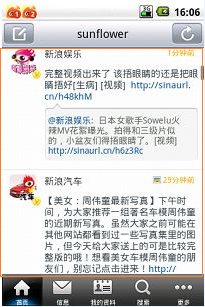[转载][Android]ListView性能优化之视图缓存(续) – 农民伯伯 – 博客园.
前言
在上一篇ListView性能优化之视图缓存我们讨论了Google I/O中的优化方法,在各个论坛发帖后得到了不错的反馈,诸如:使用ViewHolder技术Tag的问题,利用HashMap自行存储的方案等。这里结合新浪微博中主界面的做法及测试数据与大家进一步探讨。
文章
[Android]ListView性能优化之视图缓存 [本文的上篇]
[Android]ListView性能优化之视图缓存 [JavaEye讨论帖]
正文
一、新浪微博
1.1 截图
 (来自网络)
(来自网络)
1.2 反编译后相关代码
public View getView(int paramInt, View paramView, ViewGroup paramViewGroup){int i = --paramInt;int j = -1;if (i == j);for (Object localObject1 = HomeListActivity.this.getReloadView(); ; localObject1 = HomeListActivity.this.getLoadMoreView()){label26: return localObject1;int k = HomeListActivity.this.mList.size();int l = paramInt;int i1 = k;if (l != i1)break;}boolean bool1 = true;boolean bool2 = null;String str1;label110: Object localObject2;if (StaticInfo.mUser == null){List localList1 = HomeListActivity.this.mList;int i2 = paramInt;str1 = ((MBlog)localList1.get(i2)).uid;List localList2 = HomeListActivity.this.mList;int i3 = paramInt;String str2 = ((MBlog)localList2.get(i3)).uid;String str3 = str1;if (!str2.equals(str3))break label271;int i4 = 1;label156: if (paramView != null)break label277;HomeListActivity localHomeListActivity1 = HomeListActivity.this;ListView localListView1 = HomeListActivity.this.mLvHome;List localList3 = HomeListActivity.this.mList;int i5 = paramInt;MBlog localMBlog1 = (MBlog)localList3.get(i5);HomeListActivity localHomeListActivity2 = HomeListActivity.this;int i6 = paramInt;boolean bool4 = localHomeListActivity2.isNewCommer(i6);int i7 = HomeListActivity.this.mReadMode;localObject2 = new MBlogListItemView(localHomeListActivity1, localListView1, localMBlog1, bool1, bool2, i4, bool4, i7);}while (true){localObject1 = localObject2;break label26:str1 = StaticInfo.mUser.uid;break label110:label271: boolean bool3 = null;break label156:label277: localObject2 = paramView;try{MainListItemView localMainListItemView = (MainListItemView)localObject2;List localList4 = HomeListActivity.this.mList;int i8 = paramInt;Object localObject3 = localList4.get(i8);HomeListActivity localHomeListActivity3 = HomeListActivity.this;int i9 = paramInt;boolean bool5 = localHomeListActivity3.isNewCommer(i9);int i10 = HomeListActivity.this.mReadMode;boolean bool6 = bool1;boolean bool7 = bool2;localMainListItemView.update(localObject3, bool6, bool7, bool5, i10);}catch (Exception localException){HomeListActivity localHomeListActivity4 = HomeListActivity.this;ListView localListView2 = HomeListActivity.this.mLvHome;List localList5 = HomeListActivity.this.mList;int i11 = paramInt;MBlog localMBlog2 = (MBlog)localList5.get(i11);HomeListActivity localHomeListActivity5 = HomeListActivity.this;int i12 = paramInt;boolean bool8 = localHomeListActivity5.isNewCommer(i12);int i13 = HomeListActivity.this.mReadMode;localObject2 = new MBlogListItemView(localHomeListActivity4, localListView2, localMBlog2, bool1, bool2, bool3, bool8, i13);}}} |
代码说明:
代码流程已经比较混乱,但是这里能看到并没有直接的inflate,而是自定义了继承自LinearLayout的MBlogListItemView。
public MBlogListItemView(Context paramContext, ListView paramListView, MBlog paramMBlog, boolean paramBoolean1, boolean paramBoolean2, boolean paramBoolean3, boolean paramBoolean4, int paramInt){super(paramContext);this.context = paramContext;this.parent = paramListView;this.mBlog = paramMBlog;String str1 = paramContext.getCacheDir().getAbsolutePath();this.mCacheDir = str1;String str2 = paramContext.getFilesDir().getAbsolutePath();this.mFileDir = str2;((LayoutInflater)paramContext.getSystemService("layout_inflater")).inflate(2130903061, this);TextView localTextView1 = (TextView)findViewById(2131624016);this.mName = localTextView1;TextView localTextView2 = (TextView)findViewById(2131624041);this.mDate = localTextView2;TextView localTextView3 = (TextView)findViewById(2131624018);this.mContent = localTextView3;TextView localTextView4 = (TextView)findViewById(2131624046);this.mSubContent = localTextView4;ImageView localImageView1 = (ImageView)findViewById(2131624040);this.mIconV = localImageView1;ImageView localImageView2 = (ImageView)findViewById(2131624042);this.mIconPic = localImageView2;ImageView localImageView3 = (ImageView)findViewById(2131624044);this.mUploadPic1 = localImageView3;ImageView localImageView4 = (ImageView)findViewById(2131623979);this.mUploadPic2 = localImageView4;TextView localTextView5 = (TextView)findViewById(2131624047);this.tvForm = localTextView5;TextView localTextView6 = (TextView)findViewById(2131623989);this.tvComment = localTextView6;this.tvComment.setOnClickListener(this);TextView localTextView7 = (TextView)findViewById(2131623988);this.tvRedirect = localTextView7;this.tvRedirect.setOnClickListener(this);ImageView localImageView5 = (ImageView)findViewById(2131624049);this.imComment = localImageView5;this.imComment.setOnClickListener(this);ImageView localImageView6 = (ImageView)findViewById(2131624048);this.imRedirect = localImageView6;this.imRedirect.setOnClickListener(this);ImageView localImageView7 = (ImageView)findViewById(2131624043);this.imGpsIcon = localImageView7;ImageView localImageView8 = (ImageView)findViewById(2131624013);this.mPortrait = localImageView8;LinearLayout localLinearLayout = (LinearLayout)findViewById(2131624045);this.mSubLayout = localLinearLayout;this.mReadMode = paramInt;MBlogListItemView localMBlogListItemView = this;MBlog localMBlog = paramMBlog;boolean bool1 = paramBoolean1;boolean bool2 = paramBoolean2;boolean bool3 = paramBoolean4;int i = paramInt;localMBlogListItemView.update(localMBlog, bool1, bool2, bool3, i);this.mUploadPic1.setOnClickListener(this);this.mUploadPic2.setOnClickListener(this);} |
代码说明:
a). MBlogListItemView extends LinearLayout implements MainListItemView
b). inflate(2130903061,this)这个数字代表R.layout.itemview。
二、测试方案(方案五)
按照新浪微博类似的做法进行测试。
2.1 测试代码
@Override
public View getView(int position, View convertView, ViewGroup parent) {
// 开始计时
long startTime = System.nanoTime();
TestItemLayout item;
if (convertView == null) {
item = new TestItemLayout(BaseAdapterActivity.this);
} else
item = (TestItemLayout) convertView;
item.icon1.setImageResource(R.drawable.icon);
item.text1.setText(mData[position]);
item.icon2.setImageResource(R.drawable.icon);
item.text2.setText(mData[position]);
// 停止计时
long endTime = System.nanoTime();
// 计算耗时
long val = (endTime – startTime) / 1000L;
Log.e(“Test”, “Position:” + position + “:” + val);
if (count < 100) {
if (val < 2000L) {
sum += val;
count++;
}
} else
mTV.setText(String.valueOf(sum / 100L) + ":" + nullcount);// 显示统计结果
return item;
}
[/java]
TestItemLayout
[java]
public class TestItemLayout extends LinearLayout {
public TextView text1;
public ImageView icon1;
public TextView text2;
public ImageView icon2;
public TestItemLayout(Context context) {
super(context);
((LayoutInflater) context
.getSystemService(Context.LAYOUT_INFLATER_SERVICE)).inflate(
R.layout.list_item_icon_text, this);
icon1 = (ImageView) findViewById(R.id.icon1);
text1 = (TextView) findViewById(R.id.text1);
icon2 = (ImageView) findViewById(R.id.icon2);
text2 = (TextView) findViewById(R.id.text2);
}
}
[/java]
2.2 测试结果
| 次数 | 4个子元素 | 10个子元素 |
| 第一次 | 347 | 460 |
| 第二次 | 310 | 477 |
| 第三次 | 324 | 508 |
| 第四次 | 339 | 492 |
| 第五次 | 341 | 465 |
三、总结
从测试结果来看与ViewHolder性能非常接近,不会出现tag图片变小的问题(关于图片变小的问题,有朋友说是TAG中的元素对大小和位置有记忆),也能有效的减少findViewById的执行次数,这里建议完全可以取代ViewHolder。
关于ListView内部Adapter的心得大家可以看一下上文的总结4.1。
四、考虑
关于静态内部类这里不是很理解,是否能应用方案五还有待验证。
结束
优化ListView不仅仅只有对convertView的优化,还有许多这样那样的技巧,欢迎大家交流与分享 🙂
 Mikel
Mikel

